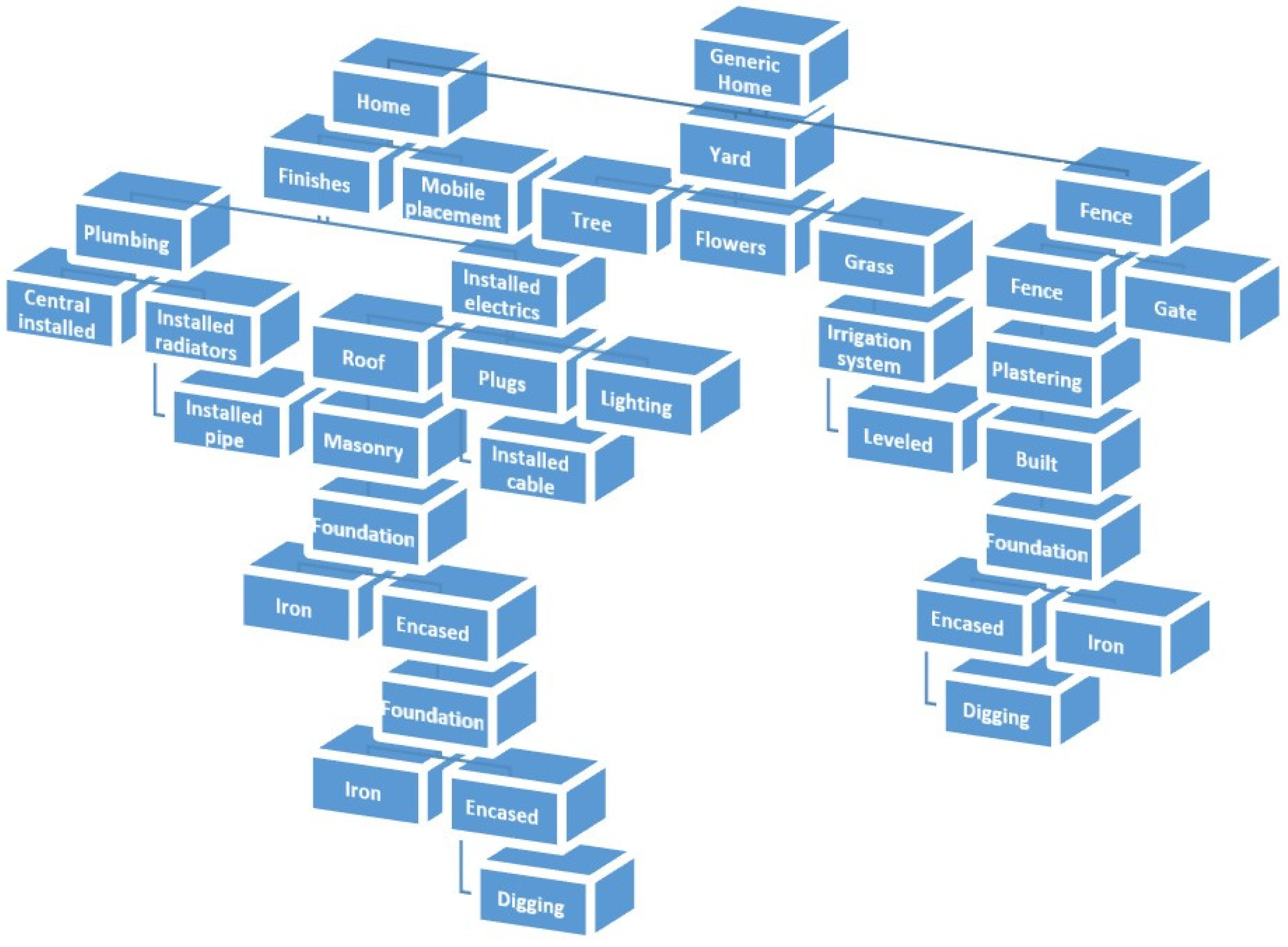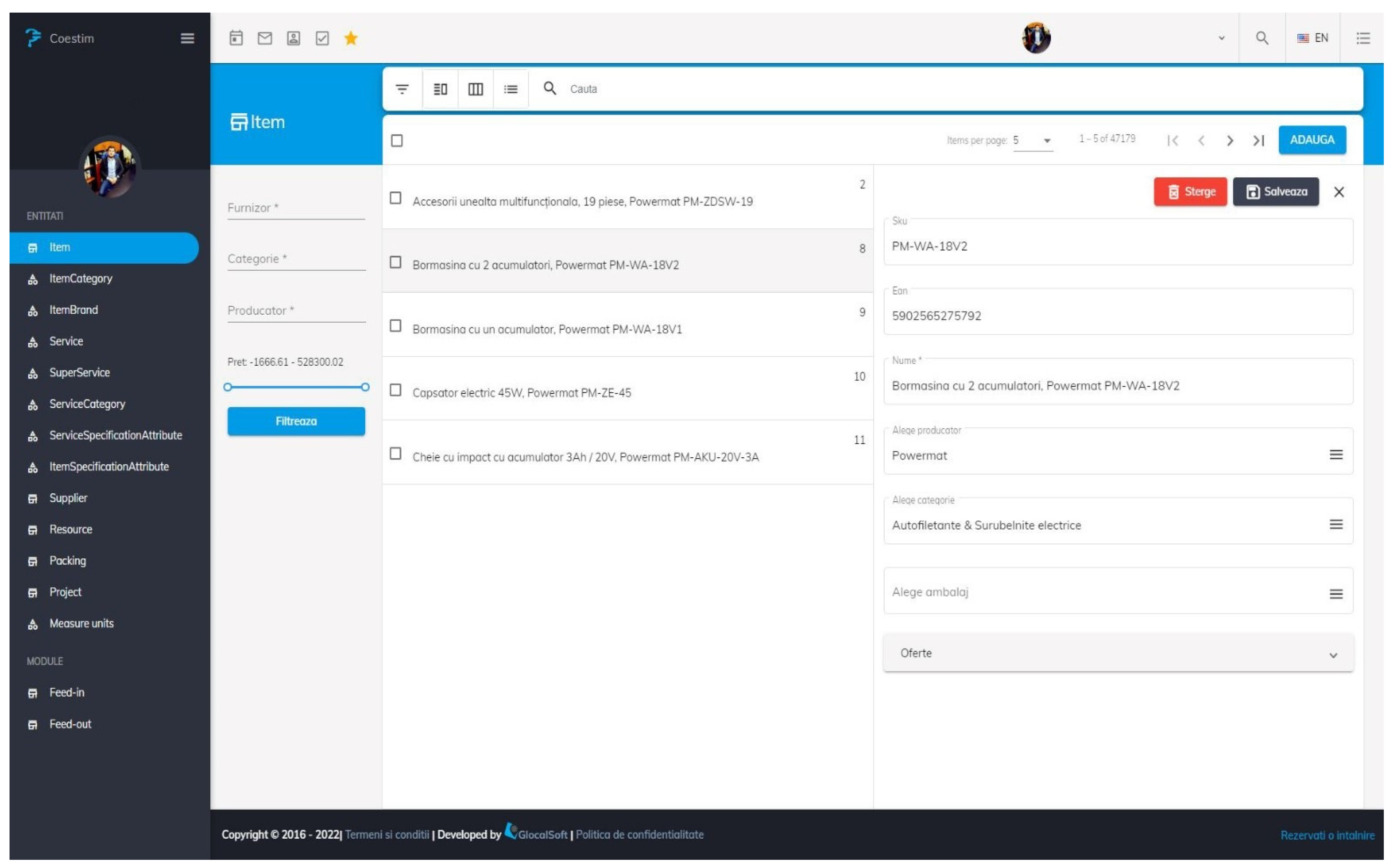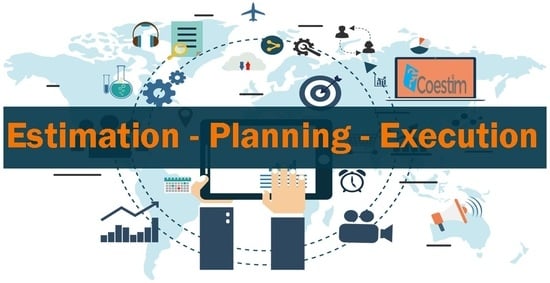Utility of Designing Intelligent Algorithms to Streamline E-Commerce Operations and Construction Costs Estimates by Applying Principles of Sharing Economy: Coestim
Abstract
:1. Introduction
Study and Analysis of Algorithms Dedicated to Cost Estimation
2. Methodology for Implementing the SaaS Solution–Coestim
2.1. Key Concepts in the Development of Dedicated Software Solutions
2.2. Benefits of Artificial Intelligence in CEM
- -
- Problems are characterized by subjective uncertainty and ambiguity.
- -
- There is a reliance on experts to make quick decisions, using subjective information and approximate reasoning based on their experience rather than accurate numerical data.
- -
- Problems are characterized by inaccurate inputs and outputs and imprecise or unstructured variables, which require heuristic reasoning based on experience and judgment rather than algorithms.
- CART is a classification method that uses historical data to build decision trees. A CART model that predicts the value of continuous variables in a set of input variables is known as a regression model. A major advantage of the decision tree-based model is its ability to manage a small data set. However, a disadvantage is that it can produce unstable decision trees. The reason is that the insignificant change in the learning sample could lead to radical changes in the decision tree.
- The tree model (MT-tree model) is proven to have the ability to learn effectively and can address high-dimensional regression tasks. Compared to other machine learning techniques, the MT training process is relatively fast and the results are interpretable.
- ANN is a viable alternative for forecasting, construction costs and, in practice, has been used to build various cost prediction models. This method eliminates the need to find a mapping relationship that mathematically describes the construction cost based on the input variables. When the influencing factors and the structure of the ANN are specified, the task is to collect a reasonable amount of data for ANN training. However, the process of training ANN-based models is often time-consuming.
- In the construction area, SVM was used in cost estimation. The principles are based on structural risk minimization and statistical learning theory. SVM-based models also involve the identification of influencing factors, data sample collection, and the training/testing process. After establishing the mapping function, the model is able to predict the future value of the project cost. The advantages are widely known for accurate prediction ability. However, the SVM training process involves high computational costs.
2.3. Software Applications Dedicated to Construction Project Management
2.3.1. Archdesk
2.3.2. SocrateERP
- -
- Management of construction works-efficient development of all construction works, quantitative-value records of all activities, by projects, phases, and sub-phases;
- -
- Cost control per project;
- -
- Management of equipment and machinery-planning and tracking, on-site, of equipment and machinery, consumption being recorded in the machine sheet;
- -
- Time management-both the human resources involved in the construction works and the Tesa staff;
- -
- On-time supply-Quality control and stock level;
- -
- Sales management-Management of the sales process;
- -
- Financial accounting management;
- -
- Integration with budgeting and project management software;
- -
- Industry-specific analyzes and reports.
2.3.3. Solvidev
- -
- Database-over 50,000 estimate rules (from 1981 to 2017);
- -
- Over 100,000 materials with updated prices from over 71 suppliers;
- -
- All forms and reports required to participate in public tenders;
- -
- General estimate;
- -
- Execution schedule complete with recommended days required for each item;
- -
- Optimized project management in the field of construction and installations;
- -
- Unlimited addition of beneficiaries, investments, objects, currencies, new materials, labor, and equipment, attached list of new materials, and equipment.
2.4. Regression Model and Fuzzy Logic Techniques
2.5. Fuzzy Logic Techniques
3. Prototyping and Proposed Implementation
3.1. Designing Project Creation Simulator—Coestim
- Going through all the hierarchical structures of the super-services:
- -
- All parent super services are identified;
- -
- For each super-parent service, the list of children is taken over;
- -
- For each parent-child structure a random number is created between one and five projects with an initial number of estimates which is incremented at each iteration and values of service quantities, where the initial values are multiplied by the iteration number.
- Adding estimates to the project:
- -
- Each super-service sequence is recursively traversed to create estimates in the same parent-child structure;
- -
- The project-estimation link is created;
- -
- For each estimate, the details specifying the items used in making it together with the prices and quantities thereof shall be added;
- -
- For each estimate, add the resources used in its estimate.
- Modeling phase: In this section, the ANN was modeled by defining the network architecture in which a series of parameters such as the number of layers, input parameters, and the number of neurons are defined. In addition, the amount of output data, the activation functions of the neuron, and the type of training function based on the network orientation were described.
- Training phase: ANN training was based either on the training of this network structure or the weight of the training. In this section, the training algorithm was selected as supervised, unattended, or reinforcement training.
- Testing phase: involves comparing the results of the proposed ANN model. This exercise is based on the data set for testing with the prospected values.
3.1.1. Schedule with Earliest Start Date
3.1.2. Get Days from Duration in Hours
3.1.3. Calculate Total Estimate Duration
3.1.4. Add Business Days
3.2. Project Execution Simulator Design–Coestim
- The simulator will not change the providers of a service or their resources
- An activity cannot be divided between resources from different providers
- Resources are limited in quantity and number of hours per day
- The number of resources allocated to an activity in a given project will remain constant until the end of the activity.
- However, the number of resources allocated to an activity may vary from project to project.
- It is assumed that resources maintain a constant level of productivity throughout the activities.
- An activity has a maximum number of resources that can be allocated at the same time.
- Each project is taken over
- o
- The list of estimates for each project is taken over;
- o
- An execution is created for each estimate;
- Allocate resources for each running estimate
- o
- The required resources are taken over;
- o
- For the necessary resources, we are looking for suppliers who can provide the necessary resources;
- o
- If we do not find a supplier for one of the resources, there will be an exception stating its lack;
- Employee allocation for each resource
- o
- For each resource the number of assigned employees is sought;
- o
- If there are no employees for one of the resources, an exception will be given stating their lack;
- Start activities
- o
- Go through the hierarchy of executed estimates and simulate the start and end dates of the activities according to the number of hours required for each resource;
- o
- Update start and end dates for each execution stage.
3.3. Designing Intelligent Algorithms for Cost Efficiency–Coestim
- ▪
- Other possible offers are being sought;
- ▪
- If other offers are found, check if there is a better price between them than the one initially set;
- ▪
- If a better price is found, the costs are calculated with the new price.
3.4. Designing Intelligent Algorithms to Optimize the Development of a Project–Coestim
- A resource cannot be divided into several activities on the same day;
- An activity cannot be divided on resources from different providers;
- For a certain activity, if any provider of a child activity has the necessary resources to carry out the activity, the algorithm will take into account only those resources and will not look for other providers;
- Resources are limited in quantity and number of hours per day;
- The number of resources allocated to an activity in a given project will remain constant until the end of the activity;
- However, the number of resources allocated to an activity may vary from project to project;
- It is assumed that resources maintain a constant level of productivity throughout the activities;
- An activity has a maximum number of resources that can be allocated at the same time.
- -
- Schedule validation
- -
- Check tables and columns
- -
- Checking keys and indexes
- -
- Verification of stored procedures
- -
- Avoid duplicates.
- pgbench −U Postgres −p 5433 −c 10 −j 2 −t 10 Coestim
- -U database user; p-port server; c-number of customers; j-number of threads; t- number of transactions per customer.
- -
- Given that the population of the database with articles is conducted by taking them from the systems of suppliers, to identify the article easier for the supplier added a text column to the entity “SupplierItem” containing a link to the article from the supplier. In the entity, “SupplierFeedOutModule” the column “CustomItemBaseMapping” is deleted because during the implementation the column “ItemBaseMapping” proved to be sufficient to save the mapping of an article to a chosen file format. A column has been added containing a code for both services and resources to make them easier to identify.
- -
- Price and quantity columns were renamed and the data type was changed to “EstimateItem” and “ProjectExecutionItem”, according to their name and type in “SupplierItemPrice”. The “SuperServiceResource” entity has been filled in with the necessary columns to specify the number of hours required for a resource and to indicate whether it is on the entire super-service. There were also changes in the data type for the quantity column in the entities “ServiceResource” and “EstimateServiceResource” to accept real values.
4. Discussion
5. Conclusions
Author Contributions
Funding
Informed Consent Statement
Conflicts of Interest
References
- Gu, S.; Ślusarczyk, B.; Hajizada, S.; Kovalyova, I.; Sakhbieva, A. Impact of the COVID-19 Pandemic on Online Consumer Purchasing Behavior. J. Theor. Appl. Electron. Commer. Res. 2021, 16, 2263–2281. [Google Scholar] [CrossRef]
- Guthrie, C.; Fosso-Wamba, S.; Arnaud, J.B. Online consumer resilience during a pandemic: An exploratory study of e-commerce behavior before, during and after a COVID-19 lockdown. J. Retail. Consum. Serv. 2021, 61, 102570. [Google Scholar] [CrossRef]
- Sohn, S. A contextual perspective on consumers’ perceived usefulness: The case of mobile online shopping. J. Retail. Consum. Serv. 2017, 38, 22–33. [Google Scholar] [CrossRef]
- Trstenjak, M.; Opetuk, T.; Cajner, H.; Hegedić, M. Industry 4.0 Readiness Calculation—Transitional Strategy Definition by Decision Support Systems. Sensors 2022, 22, 1185. [Google Scholar] [CrossRef] [PubMed]
- Di Nardo, M.; Yu, H. Special Issue “Industry 5.0: The Prelude to the Sixth Industrial Revolution”. Appl. Syst. Innov. 2021, 4, 45. [Google Scholar] [CrossRef]
- Sukrat, S.; Papasratorn, B. An architectural framework for developing a recommendation system to enhance vendors’ capability in C2C social commerce. Soc. Netw. Anal. Min. 2018, 8, 22. [Google Scholar] [CrossRef]
- Yu, P.; Gong, R.; Sampat, M. Blockchain technology in China’s digital economy: Balancing regulation and innovation. In Regulatory Aspects of Artificial Intelligence on Blockchain; Pardis Moslemzadeh, T., Ed.; IGI Global: Hershey, PA, USA, 2022; pp. 132–157. [Google Scholar] [CrossRef]
- Domagała, A.; Grobler-Dębska, K.; Wąs, J.; Kucharska, E. Post-Implementation ERP Software Development: Upgrade or Reimplementation. Appl. Sci. 2021, 11, 4937. [Google Scholar] [CrossRef]
- Matende, S.; Ogao, P.J. Enterprise Resource Planning (ERP) System Implementation: A Case for User Participation. Procedia Technol. 2013, 9, 518–526. [Google Scholar] [CrossRef]
- The World Bank. Crossing Borders; World Development Report; The World Bank: Washington, DC, USA, 2021. [Google Scholar]
- Li, B.; Lei, Q. Hybrid IoT and Data Fusion Model for e-Commerce Big Data Analysis. Wirel. Commun. Mob. Comput. 2022, 2022, 1–16. [Google Scholar] [CrossRef]
- Shen, L. Research on E-Commerce Website Design Based on User Experience—Taking Online Digital Printing as an Example. Master’s Thesis, East China University of Science and Technology, Shanghai, China, 2013. [Google Scholar]
- Garrett, J.J. Elements of User Experience; Mechanical Industry Press: Norwalk, Connecticut, 2011; pp. 52–56. [Google Scholar]
- Du, L.; Zhong, X. Research on UGC type models of socialized e-commerce websites based on user experience. Design 2014, 4, 82–84. [Google Scholar]
- Habibi, F.; Birgani, O.; Koppelaar, H.; Radenović, S. Using fuzzy logic to improve the project time and cost estimation based on Project Evaluation and Review Technique (PERT). J. Proj. Manag. 2018, 3, 183–196. [Google Scholar] [CrossRef]
- Bhosale, V.; Shastri, S.S.; Khandare, M.A. A Review of Genetic Algorithm used for optimizing scheduling of Resource Constraint construction projects. Int. Res. J. Eng. Technol. 2017, 4, 2869–2872. [Google Scholar]
- Zareei, S. Project scheduling for constructing biogas plant using critical path method. Renew. Sustain. Energy Rev. 2018, 81, 756–759. [Google Scholar] [CrossRef]
- Abdul Hussien, F.T.; Rahma, A.M.S.; Abdulwahab, H.B. An E-Commerce Recommendation System Based on Dynamic Analysis of Customer Behavior. Sustainability 2021, 13, 10786. [Google Scholar] [CrossRef]
- Wang, B.; Ye, F.; Xu, J. A Personalized Recommendation Algorithm Based on the User’s Implicit Feedback in E-Commerce. Future Internet 2018, 10, 117. [Google Scholar] [CrossRef]
- Agdas, D.; Warne, D.J.; Osio-Norgaard, J.; Masters, F.J. Utility of Genetic Algorithms for Solving Large-Scale Construction Time-Cost Trade-Off Problems. J. Comput. Civ. Eng. 2018, 32, 04017072. [Google Scholar] [CrossRef]
- Yildirim, H.A.; Akcay, C.; İstanbul University. Time-cost optimization model proposal for construction projects with genetic algorithm and fuzzy logic approach. Rev. Construcción 2019, 18, 554–567. [Google Scholar] [CrossRef]
- Akcay, C.; Manisalı, E. Fuzzy decision support model for the selection of contractor in construction works. Rev. Construcción 2018, 17, 258–266. [Google Scholar] [CrossRef]
- Ji, S.-H.; Ahn, J.; Lee, H.-S.; Han, K. Cost Estimation Model Using Modified Parameters for Construction Projects. Adv. Civ. Eng. 2019, 2019, 1–10. [Google Scholar] [CrossRef]
- Cheng, M.-Y.; Hoang, N.-D. Interval estimation of construction cost at completion using least squares support vector machine. J. Civ. Eng. Manag. 2014, 20, 223–236. [Google Scholar] [CrossRef]
- Hossin, M.; Sulaiman, M.N. A Review on Evaluation Metrics for Data Classification Evaluations. Int. J. Data Min. Knowl. Manag. Process 2015, 5, 1. [Google Scholar]
- Krantz, J.; Larsson, J. Exploring the Case Study Usage in Construction Engineering and Management Research. ICCREM 2017, 2017, 38–46. [Google Scholar] [CrossRef]
- Tzeng, G.H.; Yang, Y.; Lin, C.T.; Chie, C. Hierarchical MADM with fuzzy integral for evaluating enterprise intranet web sites. Inf. Sci. 2005, 169, 409–426. [Google Scholar] [CrossRef]
- Li, L.; Mao, C.; Sun, H.; Yuan, Y.; Lei, B. Digital twin driven green performance evaluation methodology of intelligent manufacturing: Hybrid model based on fuzzy rough-sets AHP, multistage weight synthesis, and PROMETHEE II. Complexity 2020, 2020, 1–24. [Google Scholar] [CrossRef]
- Aouam, T.; Chang, S.I.; Lee, E.S. Fuzzy MADM: An outranking method. Eur. J. Oper. Res. 2003, 145, 317–328. [Google Scholar] [CrossRef]












| Transaction per Client | Processed Transactions | Tps (Includes Database Connection Time) | Tps (Excludes Database Connection Time) |
|---|---|---|---|
| 100 | 293.59 | 346.l5 | |
| 200 | 724.76 | 860.19 | |
| 30 | 300 | 1012.95 | 1186.24 |
| 50 | 500 | 1567.23 | 1807.44 |
| 80 | 800 | 1815.44 | 2062.78 |
| 100 | 1000 | 2082.27 | 2344.75 |
| 500 | 5000 | 4056.35 | 4202.20 |
| 1000 | 10,000 | 4600.27 | 4714.37 |
| 5000 | 50,000 | 5614.74 | 5649.15 |
| 10,000 | 100,000 | 5984.69 | 6003.97 |
Publisher’s Note: MDPI stays neutral with regard to jurisdictional claims in published maps and institutional affiliations. |
© 2022 by the authors. Licensee MDPI, Basel, Switzerland. This article is an open access article distributed under the terms and conditions of the Creative Commons Attribution (CC BY) license (https://creativecommons.org/licenses/by/4.0/).
Share and Cite
Sfichi, A.; Sfichi, N.; Bădeliță, M.; Medrihan, M.; Zadobrischi, E. Utility of Designing Intelligent Algorithms to Streamline E-Commerce Operations and Construction Costs Estimates by Applying Principles of Sharing Economy: Coestim. Telecom 2022, 3, 484-503. https://doi.org/10.3390/telecom3030026
Sfichi A, Sfichi N, Bădeliță M, Medrihan M, Zadobrischi E. Utility of Designing Intelligent Algorithms to Streamline E-Commerce Operations and Construction Costs Estimates by Applying Principles of Sharing Economy: Coestim. Telecom. 2022; 3(3):484-503. https://doi.org/10.3390/telecom3030026
Chicago/Turabian StyleSfichi, Adrian, Narcisa Sfichi, Marian Bădeliță, Mihai Medrihan, and Eduard Zadobrischi. 2022. "Utility of Designing Intelligent Algorithms to Streamline E-Commerce Operations and Construction Costs Estimates by Applying Principles of Sharing Economy: Coestim" Telecom 3, no. 3: 484-503. https://doi.org/10.3390/telecom3030026








